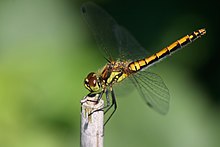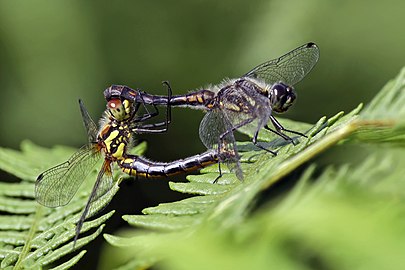Sympetrum danae
| Black darter | |
|---|---|

| |
| Male | |

| |
| Female | |
| Scientific classification | |
| Kingdom: | Animalia |
| Phylum: | Arthropoda |
| Class: | Insecta |
| Order: | Odonata |
| Infraorder: | Anisoptera |
| Family: | Libellulidae |
| Genus: | Sympetrum |
| Species: | S. danae
|
| Binomial name | |
| Sympetrum danae (Sulzer, 1776)
| |
| Synonyms[1] | |
| |
Sympetrum danae, the black darter or black meadowhawk is a dragonfly found in northern Europe, Asia, and North America. At about 30 mm (1.2 in) long, it is Britain's smallest resident dragonfly. It is a very active late summer insect typical of heathland and moorland bog pools.
Members of the genus Sympetrum are known as darters in the UK and as meadowhawks in the US and Canada.[2]
Identification[]
Both sexes have black legs and pterostigmata and a very broad base to the hind wing. The thorax has yellow sides separated by a bold black panel in which are three yellow spots, resembling a highland darter (Sympetrum nigrescens).[3]
The male has a mainly black thorax and abdomen. The abdomen has small yellow marks on the side, that darken with age. The wings are clear.[3]
The female has black legs and brown eyes. The abdomen is mainly yellow, becoming browner with age. It has small yellow patches at the wing bases.[3]
Breeding[]
This darter is restricted to acidic shallow pools, lake margins and ditches in lowland heath and moorland bogs, usually with bog-mosses and rushes. Eggs are laid in flight by dipping the tip of the abdomen into the water.[4] The eggs hatch the following spring and the larvae develop very rapidly, emerging after as little as two months.[5]

about to mate
Males basking in the sun
Population and conservation[]
In the British Isles, this dragonfly is very locally distributed in the lowlands, but more widespread in the north-west and Ireland. It is often very locally abundant and maybe this triggers dispersal. Records from the south coast suggest that immigration from the continent does occur. Its main threats, however, are development, drainage, agriculture, and peat extraction.[3]
References[]
- ^ a b Paulson, D.R. (2017). "Sympetrum danae". IUCN Red List of Threatened Species. 2017: e.T165473A65834539. doi:10.2305/IUCN.UK.2017-3.RLTS.T165473A65834539.en. Retrieved 20 November 2021.
- ^ *Black Meadowhawk, NJodes, Archive link
- ^ a b c d "Sympetrum danae". British Dragonfly Society. Retrieved 28 December 2020.
- ^ Dave Smallshire; Andy Swash (22 May 2014). Britain's Dragonflies: A Field Guide to the Damselflies and Dragonflies of Britain and Ireland – Fully Revised and Updated Third Edition. Princeton University Press. pp. 6, 142. ISBN 978-1-4008-5186-7.
- ^ "Sympetrum danae, Black Darter dragonfly, identification guide". www.first-nature.com.
External links[]
 Media related to Sympetrum danae at Wikimedia Commons
Media related to Sympetrum danae at Wikimedia Commons Data related to Sympetrum danae at Wikispecies
Data related to Sympetrum danae at Wikispecies- Black Meadowhawk, Talk about Wildlife, Archive link
- Black Meadowhawk, Insects of Alberta
- Black Meadowhawk, NaturePhoto-CZ
- Black Meadowhawk, Iowa Odonata Survey
- IUCN Red List least concern species
- Libellulidae
- Odonata of Asia
- Dragonflies of Europe
- Odonata of North America
- Insects described in 1776
- Taxa named by Johann Heinrich Sulzer


